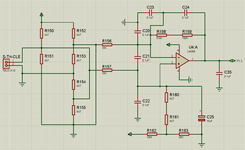gauravkothari23
Advanced Member level 2
Hi All..
I am trying to interface PT100 2 Pin with Controller. I am using NUVOTON NUC029LAN Controller.
Circuit diagram has also being attached for PT100 Interface. I am using Internal ADC of controller.
My Question is how should i calibrate PT100 with Controller. currently i am using POT to calibrate it with multimeter connected. when i connect the POT and measure the resistance at multimeter of 117.77 Ohms which is 45 Degree C, and connect it to the circuit, the resistance Increases to 175 Ohms and voltage at ADC PIN is Approx 4.10V, as soon as i disconnect the Multimeter, the voltage drops to 1.42V. so which is the correct value, and how should i interface it.
I am new in interfacing PT100 with controller.
I am trying to interface PT100 2 Pin with Controller. I am using NUVOTON NUC029LAN Controller.
Circuit diagram has also being attached for PT100 Interface. I am using Internal ADC of controller.
My Question is how should i calibrate PT100 with Controller. currently i am using POT to calibrate it with multimeter connected. when i connect the POT and measure the resistance at multimeter of 117.77 Ohms which is 45 Degree C, and connect it to the circuit, the resistance Increases to 175 Ohms and voltage at ADC PIN is Approx 4.10V, as soon as i disconnect the Multimeter, the voltage drops to 1.42V. so which is the correct value, and how should i interface it.
I am new in interfacing PT100 with controller.
